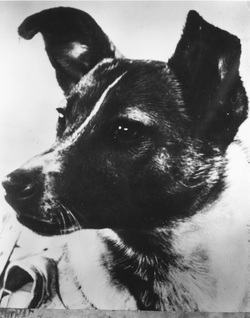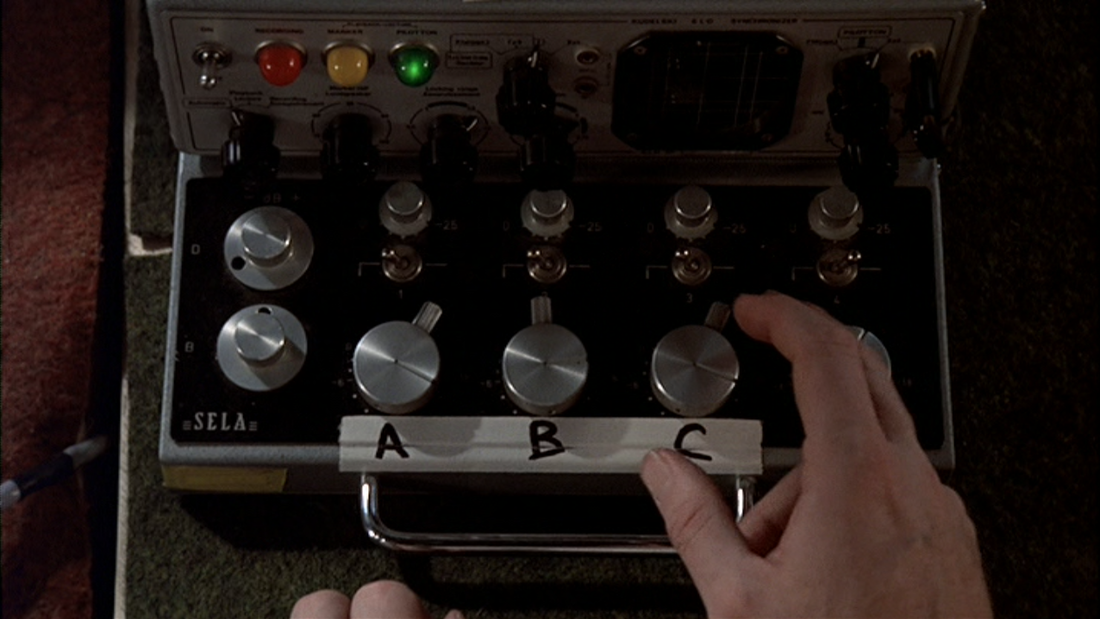
The closing lines of Alan Shapiro’s poem “Space Dog” appear on an otherwise black screen. They read, “the earnest dog eyes fixed on black space like a door the masters have walked through and will return from, surely. Surely they'll come to get me. Surely they didn't love me all that time for this.” Next there is footage of Laïka, inside of the Sputnik 2 capsule, enduring weightlessness. She looks nervous and extremely uncomfortable. She wears something similar to a space suit with an oversized helmet on her head. Additionally, around her neck is a small leash that is tied to one of the control panels, greatly restricting her ability to move. The narrator informs the audience that Laïka died merely hours into her space flight, in the process becoming the first living thing to orbit the Earth. The narrator explains that the Soviets knew that Laïka would not survive her voyage on Sputnik 2. Throughout this opening sequence, stills of Laïka in addition to the footage from the space flight will be shown.

Laïka was not the first Soviet space dog, and the audience will next be shown pictures of a few previous ones. Nikita Khrushchev holds a reception in which he commissions Sputnik 2 to be launched less than a month after the original Sputnik to commemorate the anniversary of the Bolshevik Revolution. Footage of Khrushchev and the reception will be shown. To the images of Laïka and other Soviet dog training footage, the audience will learn that Laïka was a stray, picked off the streets of Moscow. Included in this sequence will be images of her in her space suit and footage of her and other Soviet space dogs undergoing unpleasant training exercises – including living in progressively smaller cages to prepare for the satellite’s cramped quarters.
Contemporary newspaper headlines and television footage will be shown next as the impact of Laïka on the media is developed. Shortly after Laïka’s journey begins, the Soviets reveal that she will not return. However, they lie about when she expires, and initial reports claim that she lived as long as seven days in orbit. As images and footage from Laïka’s flight once again appear on the screen, reactions from Soviet citizens as well as American citizens will be investigated. For example, most Soviet citizens ridiculed Sputnik 2 as propaganda.
Contemporary newspaper headlines and television footage will be shown next as the impact of Laïka on the media is developed. Shortly after Laïka’s journey begins, the Soviets reveal that she will not return. However, they lie about when she expires, and initial reports claim that she lived as long as seven days in orbit. As images and footage from Laïka’s flight once again appear on the screen, reactions from Soviet citizens as well as American citizens will be investigated. For example, most Soviet citizens ridiculed Sputnik 2 as propaganda.

Although Laïka died in space (or perhaps because she died in space), there are several different ways in which the Russians, and the space community in general, celebrate her contribution. As images of countless different souvenirs, stamps, and monuments dedicated to Laïka fill the screen; the audience will hear a closing monologue from Dimitri Malashenkov, a Soviet scientist involved with Sputnik 2. His monologue will express deep regret at Laïka’s death and will reveal that not enough was learned to justify her loss of life. Lastly, he will state that Laïka is still the only animal sent into space with the intention of it dying there. The final shot will be of the infamous photograph of Laïka inside the capsule, with her head turned in an attentive gaze off to the left. This final text will appear on screen: “Laïka’s coffin, Sputnik 2, orbited the Earth 2,570 times before re-entering the atmosphere and burning up on April 14, 1958.”

 RSS Feed
RSS Feed